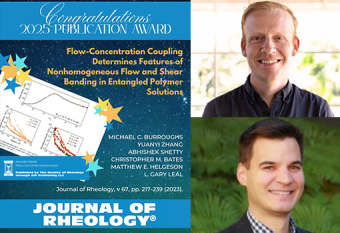
A paper led by UCSB alumnus Michael C. Burroughs (PhD ’21) has won the 2025 Journal of Rheology Publication Award. The award is given to the best paper to have appeared in the journal during the previous two years, as determined by a panel of senior members of the Society of Rheology (SOR). Titled “Flow-concentration coupling determines features of nonhomogeneous flow and shear banding in entangled polymer solutions,” the paper describes new insights into how complex polymer fluids behave under flow. The authors will receive a certificate and monetary award at the SOR Annual Meeting to be held in Santa Fe, New Mexico, in October.
Burroughs, whose PhD was co-supervised by UCSB chemical engineering professors Matthew Helgeson and Gary Leal, and is currently a Beckman Postdoctoral Fellow at Stanford University, described the recognition as “particularly special to me, since the selection committee consists of many senior rheologists whom I have known and admired since my early days as a graduate student at UCSB.”
The study addresses a phenomenon called shear banding that has long been a subject of rheological debate. A type of flow instability, it can negatively impact manufacturing processes involved in making plastic products, such as bottles, films, and fibers, which are produced by forcing thick polymer fluids to flow through machines in processes that include injection molding, extrusion, and fiber spinning. During these processes, however, the flow often becomes unstable, which can degrade product quality or even damage equipment. Despite their significance, the physical origins of such instabilities have remained mostly unknown.
Burroughs began by challenging a central assumption in theories to describe polymer flow instabilities: that the composition of polymer fluids remains uniform in a flow. “Most theories that attempt to explain polymers and other complex fluids assume that the composition of the fluid and its intrinsic properties remain spatially uniform in a flow,” explained Helgeson. “But this work shows, systematically and for the first time, that flow can actually cause these materials to ‘demix’ or separate, creating large spatial variations in concentration, which, when severe enough, can trigger shear banding.”
Helgeson described the research as “a true team success,” adding, “Every part had to work together — new materials, new instruments, and new theory. It all came together seamlessly thanks to UCSB’s collaborative environment.”
The team first had to come up with something that had not been attempted before: a way to simultaneously measure flow, composition, and stress in complex fluids as they vary within an imposed flow device. That required developing new rheo-microscopy instrumentation with custom optics, software, and advanced materials to make these measurements a reality. In the end, the team combined cutting-edge experiments with polymer flow simulations based on a recent theory developed by Leal and his group, enabling them to provide the first direct experimental evidence that shear banding in polymers can arise from flow-induced demixing.
A key idea to tag the polymers with fluorescent markers to measure polymer concentrations came from materials associate professor and Materials Research Laboratory (MRL) associate director, Christopher Bates. The chemistry was performed by Yuanyi (Alex) Zhang, (PhD ’19) from the Bates lab, who is now a technical advisor for Oblon, a company in Virginia. The team also partnered with Anton Paar, an Austrian company with laboratories in the United States, working specifically with their lead scientist, Abhishek Shetty.
The study highlights the limitations of relying solely on stress measurements in rheological experiments to characterize polymers. Burroughs recognized the importance of capturing both the flow field and material microstructure, saying, “Our work highlights the need for multi-method rheological approaches, and for future models of complex fluids to account for flow-induced changes to material composition.”



